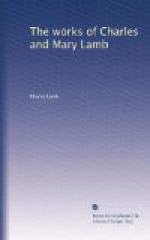What he believed in, improbable as it was to mere
terrestrial visions, you at once conceived to
be quite possible,—to be true. The
sceptical idiots of the play pretend to give him a
phial nearly full of water. He is assured
that this contains Cleopatra’s tear.
Well; who can disprove it? Munden evidently recognised
it. “What a large tear!” he exclaimed.
Then they place in his hands a druidical harp,
which to vulgar eyes might resemble a modern gridiron.
He touches the chords gently: “pipes to
the spirit ditties of no tone;” and you
imagine AEolian strains. At last, William
Tell’s cap is produced. The people who affect
to cheat him, apparently cut the rim from a modern
hat, and place the scull-cap in his hands; and
then begins the almost finest piece of acting
that I ever witnessed. Munden accepts the accredited
cap of Tell, with confusion and reverence.
He places it slowly and solemnly on his head,
growing taller in the act of crowning himself.
Soon he swells into the heroic size; a great archer;
and enters upon his dreadful task. He weighs
the arrow carefully; he tries the tension of the
bow, the elasticity of the string; and finally,
after a most deliberate aim, he permits the arrow to
fly, and looks forward at the same time with intense
anxiety. You hear the twang, you see the
hero’s knitted forehead, his eagerness; you
tremble;—at last you mark his calmer
brow, his relaxing smile, and are satisfied that
the son is saved!—It is difficult to paint
in words this extraordinary performance, which
I have several times seen; but you feel that it
is transcendent. You think of Sagittarius,
in the broad circle of the Zodiac; you recollect that
archery is as old as Genesis; you are reminded
that Ishmael, the son of Hagar, wandered about
the Judaean deserts and became an archer.
Page 169, line 16. Edwin. This would probably
be John Edwin the Elder (1749-1790). But John
Edwin the Younger (1768-1805) might have been meant.
He was well known in Nipperkin, one of Munden’s
parts.
Page 169, line 21. Farley...Knight...Liston.
Charles Farley (1771-1859), mainly known as the deviser
of Covent Garden pantomimes; Edward Knight (1774-1826),
an eccentric little comedian; John Listen (1776?-1846),
whose mock biography Lamb wrote (see Vol. I.).
Page 169, line 7 from foot. Sir Christopher Curry...Old
Dornton. Sir Christopher in “Inkle
and Yarico,” by the younger Colman; Old Dornton
in Holcroft’s “Road to Ruin.”
Page 170, line 6. The Cobbler of Preston.
A play, founded on “The Taming of the Shrew,”
by Charles Johnson, written in 1716.
THE LAST ESSAYS OF ELIA
Page 171. PREFACE.
London Magazine, January, 1823, where it was
entitled “A Character of the late Elia.
By a Friend.” Signed Phil-Elia. Lamb
did not reprint it for ten years, and then with certain
omissions.
In the London Magazine the “Character”
began thus:—




